What are the healing and healing properties of houseplants. Useful properties of indoor plants.
Modern civilization has given us cozy homes and comfortable living conditions. But you have to pay for such benefits, and first of all with your health. The fact is that household chemicals, modern building and finishing materials, household appliances emit a variety of harmful substances into the atmosphere (acetone, formaldehyde, phenol, salts of heavy metals, carbon and nitrogen oxides, ammonia), thereby constantly polluting our housing and other premises. where we have to be.
In total, there are about a hundred toxic compounds, and about 80% of them exude primarily building and finishing materials.
It can be argued that the air on the street is much more polluted than in our apartments, but in fact it is not. Scientists have found that the concentration of hazardous compounds indoors is 1.5-4 times higher than the concentration of harmful emissions in the outdoor air.
Modern interiors are overwhelmingly rectangular in design, which also has an adverse effect on the physical and mental health person.
You can find a way out, and quite simple. To cope with the negative consequences of the blessings of civilization, you just need to get healthy plants in the apartment. Indoor plants appearance able to calm, relieve stress and irritation. In addition, they have a number of useful properties that help neutralize harmful effect things around us.
❧ It is useful to put silver or precious stones in water for watering plants so that it is saturated with their positive energy.
Houseplants absorb poisonous substances
Modern building and finishing materials are one of the main causes of indoor air pollution, as they release xylolone, formaldehyde, chloroform, acetone, benzene, ammonia, toluene, trichlorethylene into the atmosphere. First of all, such a poisonous mixture is dangerous for children and the elderly, since under the influence of harmful elements health weakens and well-being worsens. The rest of the people are also exposed to the negative effects of chemicals that cause allergic reactions, dizziness and headaches, and adversely affect the functioning of internal organs.
Most indoor plants serve as a kind of natural filters, they process harmful compounds, helping to improve the air in the house. The fact is that plants have specific biological properties. Chemical elements dangerous for our health fall on the leaves and aerial roots of plants, most of which they use for their life. Symbiont bacteria live in the roots of plants, which absorb the rest of the settled harmful substances. Thus, we can say that indoor plants are a kind of biological barrier for them.
The first place in air purification from harmful impurities is crested chlorophytum. This plant seems to have been specially created specifically for the polluted air environment, in which it feels just fine. For a room of 10 m2, 4 chlorophytums are enough, which will clean the air by 70-80%. Also, chlorophytum perfectly moisturizes the air when proper care behind him. In addition, this is a beautiful plant that does not need special conditions. With proper care, it will multiply, giving tendrils-outgrowths. Aloe, spathiphyllum, ivy also have useful cleansing properties.
Variegated dieffenbachia remarkably cleans the air of toxins. If the windows of an apartment or office overlook a factory, boiler room or a road with heavy traffic, then this plant is best placed on the windowsill so that it serves as a natural barrier.
Chloroforum, aloe, ivy, dieffenbachia, philodendron (monstera), dracaena, spathiphyllum, shefflera, ficus, hamedorea will help to cope with formaldehyde.
Toluene and xylene absorb dieffenbachia, chlorophytum, anthurium, nephrolepis, ficus well.
Ammonia is neutralized by arrowroot, dracaena, ficus, azalea, anthurium.
Dracaena and ivy clean the air from benzene.
Carbon oxides absorb chlorophytum and epipremnum.
Dracaena, ivy, spathiphyllum relieve air from trichlorethylene.
Houseplants disinfect the air
During a series of experiments, which in the 1960s. conducted by scientists of the Central Republican Botanical Garden of the Academy of Sciences of Ukraine, it was found that most indoor plants produce special substances that help eliminate harmful pathogens. These substances are called phytoncides, there is also another term: volatile phytoorganic substances, or LFOV.
House plants produce and release into the air such useful substances as phenols, alcohols, terpenes and esters, which fight pathogenic microbes, fungi, viruses (stop their development and reproduction). You can simply put a few pots of indoor flowers in the room, and they will help reduce the number of microorganisms that live in its air environment.
Such a useful property of indoor plants as effective air purification is explained by the fact that they have a specific feature of capturing changes in the composition of the atmosphere around them. Chemicals that pollute the air harm not only humans but also plants. As a result, they turn on a kind of protective mechanism and they successfully cope with air purification. Some of the harmful elements are used by plants to maintain their vital functions.
Perfectly fights mold fungi in the air, prickly pear. This is a type of cactus with stalks in the form of cakes. Prickly pear reduces the number of harmful fungi by 6-7 times. Antifungal plants are also considered lemon, ivy, laurel, coffee tree. Fungi are more likely to start in dark and damp rooms, so these plants should be placed in such rooms.
Myrtle contains essential oils that help cleanse the air of microbes that cause bronchitis, colds and lung diseases. Myrtle makes it easier to breathe.
The following plants help to significantly reduce the number of microbes in the air of the apartment: rosemary, begonia, dieffenbachia, anthurium, pelargonium, sankheziya, pilea, myrtle, pellionia, crassula (money tree), thuja, brilliant spurge, aucuba, eucalyptus, epipremnum, cypress, tradescantia, aglaonema, ficus, fig, ophiopogon, cissus, sansevieria, oleander, coleus, ivy, boxwood, duranta, euonymus, agave, tetrastigma (room grapes), aloe, cherry laurel, laurel.
By placing a lot of indoor plants in an apartment or office, you can significantly reduce the number of pathogens. So, in a room measuring 15-25 m2, it is enough to have 5-7 plants so that the air remains clean and fresh.
Houseplants ionize the air
Air ionization, or air ionization, is a method aimed at improving the atmosphere in residential, industrial and public buildings. This happens due to the saturation of the air environment with negative ions (aeroions), which are electrically charged gas molecules. Scientists have proven that by changing the composition of the air and enriching it with negative ions, there is a positive effect on a person. Atmospheric ionization has a good effect on the respiratory, cardiovascular and nervous systems, helps to reduce pain, heals wounds faster, relieves allergic reactions. If you regularly carry out wellness procedures with ionized air, then this will improve your general well-being, significantly increase your working capacity, and your mood will rise. Ionized air is also able to alleviate the course of many diseases, relieve headaches. The positive effect of ionized air is observed in bronchial asthma, insomnia, arterial hypertension, overwork, stress.
There are special devices - air ionizers, which artificially saturate the air with negative ions. To do this, just turn on such a device at night and leave the window open.
❧ You can select plants suitable for a particular. In this case, the energy of the plant and the person will merge into one and support each other.
Procedures for improving the body with ionized air are carried out in sanatoriums and rest homes. But not always and not everyone has the opportunity to go there. There are many natural complexes with a high concentration of ionized air. Negative ions are found in large quantities in the air of mountainous regions, near waterfalls, in forests and parks, as well as on the sea coast. In large cities, the concentration of ionized air is found in the green spaces of park areas.
Medical and health institutions, as well as children's camps are mostly located in rural areas or on the outskirts of cities near forests. This is explained by the fact that in pine, spruce, oak forests and places where willow, juniper and mountain ash grow, there is an increased content of negative ions in the air. Since most plants ionize the air well, they are planted on city streets, planted in residential and public buildings.
Indoor plants help ionize indoor air. The result of the vital activity of indoor plants is oxygen, due to which air ionization occurs, which has a beneficial effect on human health. Plants increase the content of light ions in the air, and reduce the amount of heavy ions. Polluted air contains very few light negative ions, and it is they that increase vitality, regulate the acid-base balance of the blood, strengthen the immune system, activate respiratory enzymes, reduce arterial pressure.
In rooms where there are TVs and computers, there is a very low amount of light negative ions. Cacti and coniferous plants (cypress, thuja) help to enrich the air with them. They neutralize the negative radiation effects of the computer monitor and TV kinescope.
What houseplants increase air humidity?
All houseplants increase air humidity. Water is released through the leaves of plants, thus humidifying the air. Almost all plants return 90% of the moisture they absorb to the atmosphere; they use only 10% to maintain their vital activity.
In the process of evaporation of moisture by plants in summer time there is a decrease in air temperature by several degrees, and humidity increases by 10-20%.
The following plants give a lot of moisture: sparmania, dwarf ficus, hibiscus, fatsia, dracaena.
Cyperus perfectly moisturizes the air, in addition, it has phytoncidal properties.
Dieffenbachia has a large leaf area, as a result of which it increases the water-gas exchange in the apartment.
Nephrolepis is able to greatly increase the humidity of the air. Also this plant is very beautiful and can be used for single placement in the interior.
Sparmania promotes humidification and ionization of the air.
Fatsia moisturizes the air well, is very hardy, its height reaches 1.4 m, in the interior it can be used for single placement.
Monstera, cypress, thuja not only perfectly moisturize the air, but also absorb formaldehyde. Asparagus, anthurium, aralia, maidenhair, rose absorb heavy metals, help fight irritability, fatigue, stress and increase air humidity in the apartment.
Which houseplants collect dust?
Sources of house dust are keratinized human skin cells, indoor plant pollen, books, hair, pillows and blankets, pet hair, upholstered furniture. It is impossible to get rid of house dust completely, since its source is always present in the apartment. That is why, one has only to wipe the dust from the surface, as it immediately appears again.
To create a special atmosphere and microclimate in the apartment, indoor plants help, which also do an excellent job with dust, absorbing part of it. In order for the plants to fight dust well, they must be watered regularly, wipe the leaves with a damp cotton swab or napkin, and spray the aerial part.
Plants such as aloe, chlorophytum, ivy, dracaena, help fight dust.
What indoor plants repel insects?
Many plants have the ability to repel insects. For example, mosquitoes are very sensitive to the smell of mint. Therefore, in the apartment you can grow plectranthus, which has a pleasant mint aroma. It is popularly called: “room mint”. You can also use fresh leaves and stems of this plant, spreading them around the apartment. To prevent mosquito bites, it is recommended to rub the skin with plectranthus leaves. Some indoor plants, such as laurel, contain camphor, which is extremely unpleasant for mosquitoes.
Houseplants that repel mosquitoes include myrtle, pelargonium, and rosemary. In the evening, it is recommended to lightly shake the plant pots, then their smell will fill the room and repel insects.
Also, essential oils of geranium, camphor laurel, eucalyptus, tea and coffee trees, and rosemary are used to fight mosquitoes. Essential oil contained in citrus fruits effectively repels mosquitoes. You can drop a little lemon oil into the aroma lamp and go to bed with the window open. This will not only rid the room of mosquitoes, but also fill the room with a pleasant smell that helps to relax and calm down. However, when using essential oils, it is necessary to comply with the norm, since an overdose can lead to nausea and headache.
Many insects do not tolerate the smell of eucalyptus, geranium. The essential oils of these plants should be lubricated on the skin to prevent insect bites. You can also put a few drops on a cotton swab and put it on the windowsill, then the insects will not fly into the apartment through the window. Geranium contains substances that mosquitoes are very afraid of, so their number is sharply reduced in the premises where this plant stands.
Geranium essential oil is also used for aroma lamps. A pleasant strong aroma will spread around the room, which mosquitoes will definitely not stand.
Essential oils of indoor coniferous plants (thuja, cypress) are perfect against flies and cockroaches.
Lemon leaves, oleander flowers (which, among other things, belongs to poisonous plants) are also considered to repel them. Insects do not like the smell of pelargonium (geranium), which is popularly called "flycat". You can scare away insects with the help of smoke from dried cypress needles and its cones.
Pink geranium, thuja needles and leaves, lemon fruits, and common ivy also help to cope with the invasion of insects. Decoctions of them can be used to wipe your hands and face to protect yourself from insect bites.
Petunia and rosemary are also used as an insect repellent. It is enough to arrange pots with these flowers around the apartment, as the number of insects will drastically decrease. The moth hates the smell of pepper and geranium. You can put indoor pepper next to the closet where winter clothes are stored. Plectranthus (room mint) is also called the "moth tree": its leaves contain an essential oil that is unpleasant for moths. The crushed leaves of this plant exude a spicy aroma that repels moths.
Plant growth can be stimulated by pot size. The larger the pot, the more roots the plant develops and, accordingly, it grows strongly.
Indoor plants help in flavoring the room
Not everyone thinks about it, but all kinds of smells are an integral part of our lives. human nose able to distinguish about 10,000 different aromas. Many smells have a great impact on our physical and moral health, improving it and keeping the body in good shape. Therefore, it is so important that Everyday life pleasant aromas surrounded us. This can be achieved by growing indoor plants at home, then our life will become more joyful and healthy.
Plants with a persistent smell will not only fill the apartment with a pleasant aroma, but also repel insects and rid the house of pathogenic microbes. Geranium and plectranthus have a special aroma that can cleanse the apartment of insects, and cure the owners of insomnia. Many bulbous plants can be used as a room fragrance, such as zephyranthes, which has an unusual aroma. In addition, the smell of this plant contributes to the speedy recovery from many diseases.
Citrus plants (lemon, tangerine, orange, grapefruit) improve brain activity, increase the amplitude of brain biocurrents. Lemon releases an essential oil into the air, the aroma of which helps lower blood pressure. Lemon leaves have a specific pleasant smell that fills a person with vivacity, increases overall tone. As a houseplant, lemon is recommended for people whose activities are related to mental work. For the same reason, you can grow lemons in educational institutions.
The leaves of fragrant geranium (another name is pelargonium) contain an essential oil that has a calming effect. Such a plant is advised to have for those who suffer from insomnia, headaches and diseases of the nervous system.
Plectranthus has a strong and fresh smell that helps relieve fatigue, irritability, aggressiveness, bring back to normal nervous system. The aroma of plectranthus provides an opportunity to gain concentration, it is especially recommended for knowledge workers. American psychologists advise people working at a computer to have this plant in their workplace.
Myrtle was considered a sacred flower in Ancient Egypt. As a houseplant, it is valued for its unusual leaf fragrance, and it also blooms with graceful pale white flowers that make it a decoration of any interior. The essential oil of myrtle is found in its dark green, leathery leaves.
In apartments, it is recommended to grow flowers with amazing aromas. Essential oils of such plants are found in stems, seeds, leaves or roots. Essential oils of spicy plants give people their healing power, having a beneficial effect on the human body.
Many of us have thought about how to humidify the air in the room, but this is one of the most important conditions for maintaining health. We all know that for the normal functioning of the body, it is necessary not only proper nutrition but also enough water. Moreover, moisture should enter the body not only in the simplest way - through the esophagus. Not less than important condition is sufficient humidity at home. In the event that this indicator is lowered, the skin and hair deteriorate, problems with the mucous membrane and lungs begin.
The issue of maintaining air humidity is especially acute when children appear in the house. Most of the future health is being laid right now, and health problems that appeared in childhood will result in very serious "sores" later. Therefore, as soon as a baby has appeared in the house, it is worth considering how to maintain a sufficient level of humidity in the room. And it is better to do this even before childbirth, so that the pregnancy proceeds easier. The normal moisture content in the air is a guarantee that expectant mother it will be easier to breathe less problems with eyes, lungs and lower risk of disease.
Why humidify the air?
Water is present in our body almost everywhere: blood, mucous, skin. Naturally, the loss of moisture is reflected in the work of the whole organism. Normal humidity is considered to be around 40-60%. If this indicator falls below, then people begin to feel a sore throat and nose, burning in the eyes, shortness of breath, hair becomes dull, the skin peels and cracks. In general, little pleasant and useful. And you can drink liters of water, but this may not be enough to correct the situation. It is worth thinking about how to humidify the air in the apartment. In most cases, this is enough to make furniture, flowers, and, most importantly, households feel better.

Buying a Humidifier
A household air humidifier is good because it does not take up much space and quickly creates a comfortable atmosphere in the room.
There are three main types of humidifiers on the market - cold, hot and ultrasonic. The former work on the basis of special cartridges that evaporate moisture into the air. Such units are inexpensive and evaporate moisture slowly, so that the humidity of the air never becomes too high. In turn, slow operation is also a minus of the humidifier. In addition, you will have to periodically change cartridges, which is not very convenient.
"Hot" humidifiers work on the principle of boiling water. Therefore, if you decide to stop at this option, make sure that there is a function to turn off the device at the moment when all the water from the tank has evaporated. This type humidifier is convenient because it quickly creates a comfortable atmosphere and does not require replacement of cartridges. But it consumes more electricity than a "cold" humidifier.
The third type of humidifiers is ultrasonic. These are one of the most popular devices due to their compact size and high performance. The inconvenience of using ultrasonic humidifiers can only be attributed to the fact that it is necessary to periodically change the pre-filters and it is desirable to use distilled water. Other than that, it's one of the most the best options to create comfort in the room.
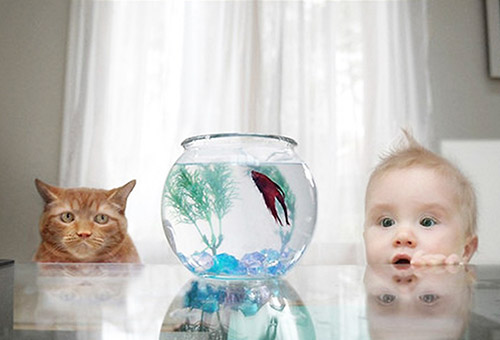
How to humidify the air without a humidifier?
Of course, not everyone has the opportunity to purchase a special device. And not everyone likes the cost of electricity, replacing cartridges and constant monitoring of the quality of the water being poured. Therefore, many are trying to find ways that do not require all these difficulties and financial investments.
- grandfather's variant, which is still successfully used by many homeowners - water containers placed at home, or wet towels on the battery. There is nowhere cheaper, the efficiency is high, but there are also negative points. It is necessary to arrange the containers in such a way that they do not interfere underfoot. Yes, and you need to constantly make sure that the fabric is wet, and pour water into the basins in time.
- Aquarium . A wonderful option for humidifying the air at home, plus an excellent interior decoration. An aquarium will keep your apartment consistently humid, and watching the fish is a well-known stress reliever. But if you are not ready for the care of living creatures, for periodic cleaning of the aquarium and the like, then this option is not for you.
- Houseplants. Perhaps this is the best option for those who are thinking about how to bring the humidity in the house to the required level. th parameters. There are many plants that are unpretentious in their care and at the same time moisturize the air. In addition, living plants in an apartment are always beautiful, and by their very presence they instantly create a cozy atmosphere.
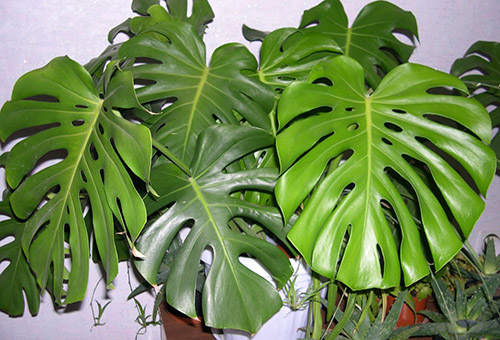
Plants that humidify the air in the apartment
We are accustomed to perceive indoor flowers as interior decoration. But in addition to the attractiveness, home plants also bring considerable benefits to people. There are plants that have an antibacterial effect, affect the quality of sleep, relieve stress. But since now we are talking On the other hand, consider home flowers that moisten the air in the room.
- Scheffler. A stunningly beautiful indoor flower, capable, moreover, of maintaining normal air humidity. True, there are some features of care, non-compliance with which can lead to the death of shefflers. The following conditions are necessary: abundant light, air temperature not lower than 16 degrees, moderate watering. The most difficult thing in caring for a shefflera is maintaining soil moisture. The soil should not be allowed to dry out, but excessive watering is detrimental to the plant. If you manage to find the "golden mean", then there will be no problems with caring for the sheffler.
- Monstera. Great home humidifier. You will be required to provide her with the following conditions of existence: the air temperature must be at least 17 degrees, sufficient lighting (but without direct sunlight), abundant watering and spraying the leaves. Provide the monstera with these conditions, and it will delight you with a gorgeous view and take care of maintaining the humidity of the air. The only thing to keep in mind: monstera leaves are poisonous. Therefore, if there are pets or small children in the house, this option is probably not for you.
- Cyperus. A plant from the papyrus family will be an excellent decoration for your interior. At the same time, cyperus is able to evaporate up to three liters of moisture per day, due to which optimal humidity will be maintained in the room without unnecessary tricks. This plant is one of the best for home keeping. Cyperus will grow well both in a warm room and in a cool one, there are no special requirements for lighting and placement. The most important thing in caring for this plant is fresh air and abundant watering.
- Ficus. One of the most beloved and popular houseplants. Ficus can be found in almost every apartment. It is believed that this plant is able to attract financial well-being to the house where it grows. You can purchase it for this purpose, and air humidification will be an additional plus. In order for the ficus to feel good, the following conditions will be required: heat, abundant (but not direct) light, watering as the soil dries.
- Dracaena. Also quite common and unpretentious plant. Provide Dracaena with warmth, light, and regular watering, and it will grow into a beautiful and vigorous plant that does a great job of keeping the humidity in the room.
These are one of the easiest houseplants to care for and will release a fair amount of water into the air. In general, if you decide to maintain humidity in the apartment with the help of flowers, then you can take any tropical plant. It is only worthwhile to read in advance about the features of care, in order to prevent the death of the plant later. Fortunately, now you can find a sufficient amount of information on this topic.
As you can see, there is more than one answer to the question of how to humidify the air at home. Whether it will be a purchased "assistant" or some other option - make a choice for yourself and take care of creating comfort in your home.
big role in life flora plays humidity. It is measured with hygrometers of various types. It is useful to know that normal room air with central heating operating has a relative humidity in the range of 20-40%. At the same time, it is well known that a humidity of 60-75% is more suitable for people and plants. Too dry air dries the mucous membranes of the nasopharynx, which leads to a decrease defensive forces organism.
Many indoor plants come from tropical forests, and therefore are accustomed to high humidity. Often the air in our homes does not meet the level of humidity that our green pets need. Low humidity air increases transpiration and evaporation of water from the substrate, which can lead to desiccation, which is fatal for plants. The lower the air humidity, the stronger the evaporation of water from leaves and soil, the more often watering is required. To make your houseplants stay on our windowsills more comfortable and healthy, you need to spray them regularly. It is necessary to spray the plant from all sides, but in no case when direct sunlight falls on it. Drops of water on the leaves form a prism effect and cause burns.
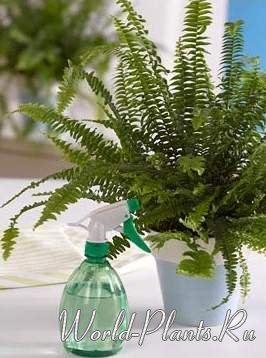
Spraying not only temporarily increases the humidity of the air, in hot weather it saves the plant from overheating, protects against infection by red spider mites and cleans leaves from dust. By the way, for the prevention of pests and for cleaning the plant from dust, a warm shower is very useful, about once a month. At the same time, do not forget to close the earthen lump with plastic bags from water.
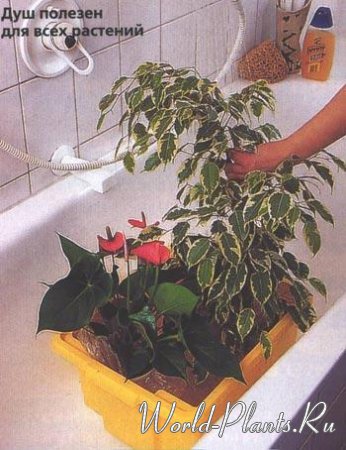
The rest of the time, once a week, be sure to wipe the leaves with a damp soft cloth.
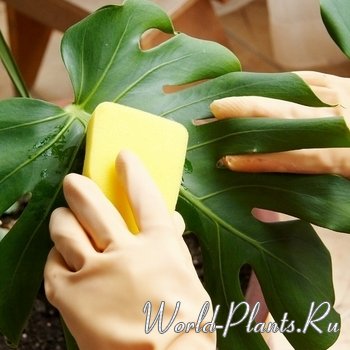
Humidity should be directly proportional to temperature - the higher the temperature, the higher the humidity. If the room temperature decreases, then the humidity level also needs to be reduced.
During summer and winter periods, the air humidity in our apartments can decrease by more than 50%. And this is hard to tolerate by most plants. To help them endure a difficult period, you need to spray the leaves of plants in the morning so that the leaves dry out by evening. And the opened flowers must be protected from water in order not to damage them.
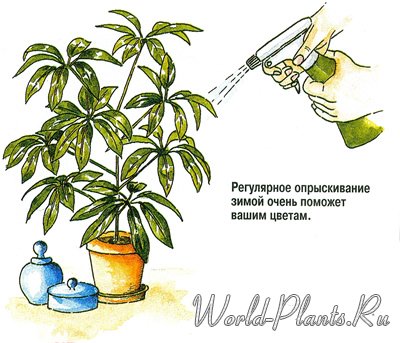
During the heating season, houseplants often suffer from dry air. Plants in a dry atmosphere are forced to evaporate more moisture - this leaves the leaves drooping and curling, and the plants themselves often fade, become dull, and the most sensitive to dry air even shed their leaves. To an inexperienced lover of home flowers, it may seem that they are dead. In this case, you can put the pots on a layer of expanded clay, poured into a pan and filled with water to half the thickness of its layer. This is the best way to ensure sufficient humidity. The spongy structure of this material is able to retain and gradually evaporate moisture into the air surrounding the flowers for a long time, which is required for their successful maintenance. In this case, you can do without spraying plants.

It is now possible to humidify the air in rooms with the help of decorative indoor fountains, special industrial air humidifiers. Moreover, the fountains can be both large, placed on the floor, and desktop.


You can also hang evaporator vessels of various designs from the batteries. They are very pretty: stylishly made of ceramics, they serve as an interior decoration, while improving the air environment at home. The easiest way is to put vessels with water near the batteries, which you will water your plants in a day. The humidity in the room will increase if winter period hang up wet towels.
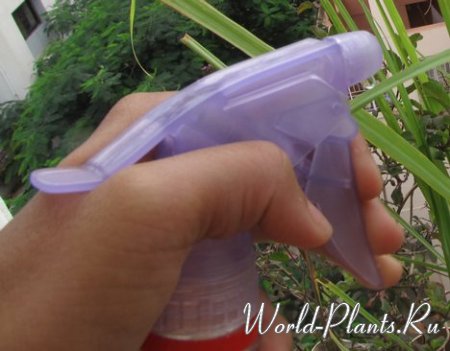
Humidity in a dry apartment can be increased by spraying indoor flowers from a spray bottle. But not everyone loves such a shower: plants with pubescent (velvet) leaves, such as pelargonium, synningia, saintpaulia, coleus, tidea or gloxinia, cannot be sprayed, as this causes yellow or white spots to form on their leaves and they can rot . Dust is removed from them with a soft dry brush. At the same time, these are moisture-loving plants, so they cover the pot with wet moss or put the pot in a pan with moistened sand. In this way, you will create the humidity around the plants that they need.
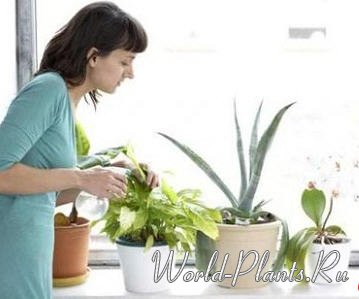
Sufficient air humidity helps the aerial parts of plants to exist, preventing them from drying out. Some types of plants (monsters, philodendrons, syngoniums, etc.) also have aerial roots that can absorb moisture from the air and additionally feed the plant's body with it.
Do not arrange the plants alone, they will be more comfortable together. The thicker the plants grow, the greater the surface of the earth (wet) evaporates moisture. Plants help each other to survive. Combine them on a pallet with 2 cm of pebbles. Pour water into the pan so that it covers only the lower stones. Put the pots on the pebbles. Leave free space between them, because with a very dense arrangement, another nuisance can happen - fungal diseases. Naturally, the more flowers live in a room, the more humid the air in it: watering and evaporating moisture with leaves make the atmosphere of the rooms healthier and more comfortable for both plants and their owners.

Small plants can be kept in glass aquariums - florariums, immersed in sphagnum or other substrate.

With light spraying in such balls, it is easy to maintain high humidity.
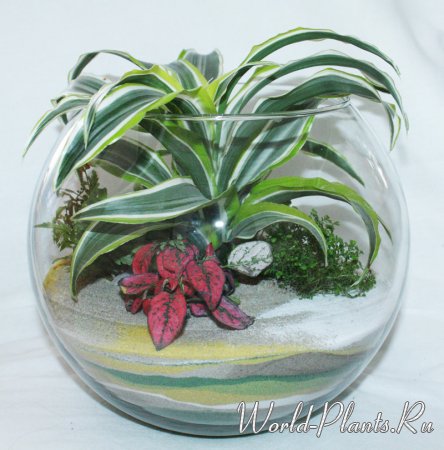
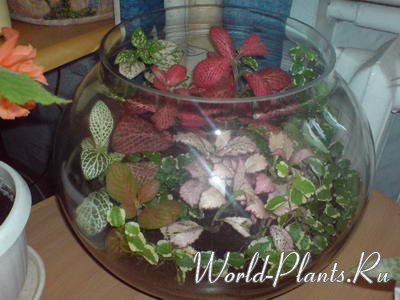
However, optimal humidity can only be achieved in a climate-controlled room greenhouse.
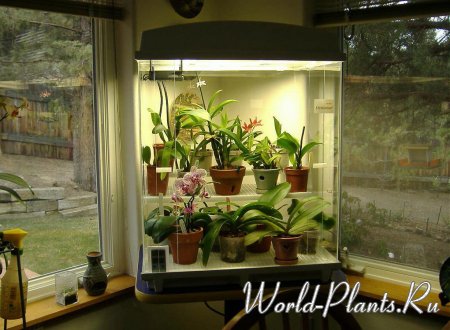
Sometimes one particular plant needs to urgently increase the humidity in order to "revive" it. The plant must be watered, sprayed with water and covered with a plastic bag. Monitor the humidity, do not forget to ventilate (so that mold does not appear and the roots do not rot). Usually, watering the soil will not be required soon.
Take a close look at your flowers. If you find dry edges on the leaves, be sure to place containers with water next to the plants, and even better - with wet sand, expanded clay or moss. Then the moisture will not evaporate quickly.
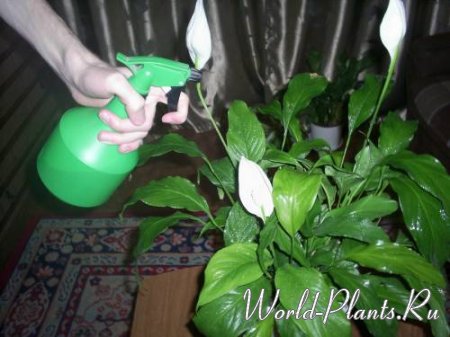
The provision of a plant with water affects its appearance and life support features. Based on this, the following plant groups:
Xerophytes - plants of dry habitats. They have a specific look and a number of special devices. Xerophytes are found in places with a dry hot climate (dry steppes, deserts and semi-deserts). Dry conditions can be observed even in rainy tropical forests - for example, many epiphytes growing on the upper branches of tall trees experience a lack of moisture. The features of xerophytes are a decrease in the size of the leaves, their pubescence, the presence of a thick skin, a wax coating on it, numerous veins and stomata. Some xerophytes have a highly developed root system or special organs that store water. Xerophytes, unlike hygrophytes, can regulate water evaporation well. The best known types of xerophytes are succulents, hard-leaved, thin-leaved and false xerophytes.
Hard-leaved xerophytes withstand drought thanks to a powerful root system. These are mainly shrubs and trees (for example, saxaul).
thin-leaved xerophytes - plants with a root system penetrating to a depth of 10-15 m.
False xerophytes - annual or perennial plants with a very fast development cycle. By the onset of the summer drought, they have time to form seeds and go into a dormant state.
hydrophytes - aquatic plants that are completely submerged in water or have leaves floating on the surface.
Hygrophytes- plants of wet habitats (rainforests, swamps, coasts of water bodies). These are herbaceous species with a weak root system, a high ability to evaporate water, and an underdeveloped mechanical tissue. They absolutely cannot stand even a short-term drying of the substrate, they love moist air. Outwardly, they are characterized by large thin leaves, sometimes with a drip tip, along which water flows (for example, some ficuses), special outgrowths on the leaves to enhance the evaporation of water (for example, imperial begonia).
Mesophytes - Plants requiring medium humidity conditions. This group includes most indoor plants. For many plants grown in room conditions, humidity of the order of 70-80% is needed, while usually the humidity is of the order of 50%. Tropical species with thin delicate leaves (fittonia, arrowroot, selanginels, ferns) need an air humidity of about 90%. To maintain high air humidity, especially in winter, it is very useful to use household humidifiers.
succulents - plants with succulent, fleshy leaves or stems (euphorbia, cacti, agaves, etc.) that store water in tissues. Succulents grown indoors do not suffer from dry indoor air, unlike other plants.

Outcome:
1. To spray plants, purchase a spray bottle with a fine nozzle: water should turn into mist on the leaves, and not squirt.
2. Use only soft warm water for spraying.
3. You need to spray often, but the main thing is that the leaves dry out completely by night, otherwise fungal diseases of indoor plants may occur. Best time for spraying plants - in the morning, when the sun has already come out. If it is too hot and the plant suffers from dry air, you can additionally spray it during the day and evening.
4. In summer, be sure to spray the plants. As for winter, indoor air
overdried by central heating batteries. Rearrange the flower from the battery and spray it.
5. If the air temperature is low indoors or on the balcony in summer, do not spray the flower, otherwise it may freeze, and hypothermia does not have the most positive effect on the health of indoor plants.
Decorating our home, purchasing furniture and decorative elements, we usually do not think about the fact that the air quality in our house may not change for the better. It's all to blame for the various substances that our new clothes can emit. Electrical appliances, laminate flooring, linoleum and even ordinary paper napkins can contain traces of formaldehyde in contact with the air in our home. Our green pets will help in the fight for air quality. Many plants are able to purify the air at home, collecting dust, smoke and other particles and heavy compounds that are hazardous to health.
What are these plants? I have selected for you several types that are easy to care for, beautiful and can significantly improve the air in the house.
Having settled indoors, chlorophytum (Chlorophytum) becomes its lungs: it collects carbon monoxide and many toxic substances from the air. For the removal of formaldehyde from the air and for the release of oxygen, it has no equal. For many housewives, it seems too simple, but if you add an interesting planter or hang it on an unusual support, you will understand that it is not as simple as it seemed at first.
After chlorophytum, Benjamin's ficus (Ficus benjamina) is the best in terms of air purification from dust and toxic compounds emitted by furniture and plastic objects. An interesting feature of this plant is that in the process of its growth, its roots can be twisted into a variety of bizarre shapes.
The flowers of Spathiphyllum (Spathiphyllum) are often called "bread" by the hostess. He is not only handsome, but also very hardworking. It picks up mold spores from the air, and also cleans the air well from trichlorethylene and formaldehyde.
4. Geranium, she is a pelargonium
Despite the fact that geranium (Pelargonium) can adversely affect an allergic person, it should not be left unattended, as it is able to cope with pathogenic microbes and bacteria in the air. It's all about its essential oils, which, in the absence of contraindications, have a beneficial effect on the human body. Geranium improves sleep and calms the nervous system.
5. Sansevieria, or "mother-in-law's tongue"
I never tire of repeating: this is just an extraordinary plant. Believe it or not, I forgot it on the balcony for a month in the summer. Temperatures there reached over 35°C during the day. It seemed that there was no chance of salvation, but sansevieria surprised with vitality! I watered the dry shoot of the plant and moved it to the shade, and then found a green area near the rhizome. To celebrate, I fed it with liquid fertilizer, and after six months it became more beautiful than before.
It is scientifically proven that this plant absorbs nitrogen oxides and formaldehydes. For the nursery, kitchen, and for any room - a good purchase.
6. Bamboo palm, she is also a hamedorea
Hamedorea (Chamaedorea) is a very beautiful plant, it will definitely be the queen in the home garden. It perfectly removes formaldehyde from the air, and also moisturizes it, due to which it is easier to breathe.The name of this palm comes from 2 Greek words: dorea, which means gift, and chamai, which means dwarf. In fact, this “gift” is certainly not so dwarfed (at home it reaches up to 2 m in height), but it is very useful and beautiful. Take a closer look at such common species as graceful chamedorea (Chamaedorea elegans) and high chamedorea (Chamaedorea elatior).
More than once I heard the opinion that gerbera (Gerbera) is a useless plant and is purchased for beauty. And although the gerbera is one of my favorite flowers, I thought so too. Imagine my surprise when I found out that she absorbs benzene from the air. It also improves sleep: Gerbera absorbs the carbon dioxide we exhale and releases oxygen instead.8. Cypress
Cypress (Chamaecyparis) picks up dust and negative ions emitted by electrical appliances from the air. And in return it gives us positive ions, thereby discharging the air. Makes the air noticeably cleaner, fresher and more pleasant.
9. Lemon and orange trees
Citruses are great air purifiers. The air in the room where lemons grow is free from germs and bacteria. The essential oils of this plant are very useful, they calm the nervous system, and the air seems to be saturated with freshness. For many people, it is very troublesome to care for, but for someone it grows just like that, without much effort.
10. Begonia
Begonias (Begonia) grow in many apartments in our country, and for good reason! They attract dust and make the air more humid. It is only necessary to spray the plant with a spray gun so that a new portion of dust, like a vacuum cleaner, is absorbed by the plant. In addition, begonias kill most fungi and microbes from the air. In addition, they help to cope with the radiation of electrical appliances. And beautiful flowers - as a bonus to so many useful properties.
11. Laurel noble
In the houses of Europe, laurel (Laurus) is by no means a rarity, but with us it is a real curiosity. Just woven from usefulness. The air will cleanse of dust and germs and helps with various diseases. Despite the outward simplicity, the plant is amazing in its healing and cleansing properties.
People with frequent lung diseases dieffenbachia (Dieffenbachia) will be just the way. It is able to destroy staphylococci that cause various unpleasant diseases. Also, the plant traps and destroys toxic substances (toluene, xylene) emitted by paint and varnish coatings of floors and walls.
Dracaena (Dracaena) is also an excellent air orderly. At one time in our kitchen with windows on the Yaroslavl highway there lived a small dracaena. Thanks to her, there was no foreign smell from the street in the room, there was no gas contamination. She perfectly takes away from the air not only benzene, but also trichlorethylene, flying with exhausts directly into the apartment.
Aloe (Aloe) is, probably, everyone, and very much not in vain. And if not, you should definitely get it. It will remove almost all formaldehyde compounds emitted by furniture, and in illness it is generally irreplaceable! It will help with a cold or runny nose - it is enough to instill a few drops of juice into the nose for prevention and treatment. Aloe phytoncides help relieve physical fatigue and stimulate brain activity.
15. Scheffler
Finally, I'll tell you about the sheffler (Schefflera). She is a real gift for the smoker or, rather, for his non-smoking relatives. Not only "smokes" with you, inhaling tar and nicotine, but also neutralizes them.
Air humidity is one of the most important characteristics for the care of indoor plants, which is often overlooked. But the homeland of many indoor plants is precisely tropical rainforests, so indoor plants suffer greatly from the dry air of our apartments and houses, especially during the period when central heating is turned on. Consider some of the signs that indicate a lack of air humidity, and find out how to increase the humidity in your apartment.
Humidity and indoor climate.
Humidity and indoor climate are important not only for plants, but also for us. Many people feel much better with high humidity. The most optimal air humidity for a person is from 45 to 55% at an air temperature of 18-24C. In almost all apartments, the air humidity is below normal, because of this, dryness of the mucous membranes and respiratory tract may occur, which may result in coughing and hoarseness. At the same time, we spend 20 hours a day indoors. Here again I want to recall our indoor plants. After all, they not only purify the air from various harmful impurities, the leaves of plants evaporate water and thus contribute to an increase in air humidity, making the indoor climate more favorable for people's well-being. Naturally, to improve the indoor climate, it is necessary to use, first of all, such indoor plants that can release a sufficient amount of moisture. Take, for example, cyperus, which absorbs about a liter of water per day. This plant absorbs only 2% of this liquid, while the plant evaporates the rest of the water. And if you arrange an indoor garden with a pond in the room, the air humidity will increase even better, and the indoor climate will become more favorable.
Signs indicating a lack of humidity.
A lot of indoor plants are accustomed to more humid air than what is in our apartments. Houseplants suffer mainly from a lack of water in the air, rather than from its excess. In dry air, plants begin to evaporate through stomata on the leaves. more water, and their water balance is disturbed:
Leaves are wrinkled or curled.
The tips of the leaves dry up. Often this can be observed, for example, in ficus Benjamin, as well as in cyperus.
Young leaves do not fully develop.
The buds do not open or fall off at all.
Some pests are especially often affected by indoor plants if the air in the room is too dry. These are mainly spider mites, whitefly and thrips.
How to increase humidity.
There are several ways to increase indoor humidity.
Spraying.
This simple and effective method helps to increase the humidity in the immediate vicinity of the plant. It is best to spray indoor plants in the morning so that the leaves dry out during the day. To do this, you need to use soft water, then limescale will not remain on the leaves. If direct sunlight falls on the leaves of plants, then it is impossible to spray, drops of water play the role of lenses, and the plant will suffer from a burn. Sometimes spraying plants can be difficult due to certain circumstances: it is undesirable for electrical appliances to get water, some surfaces do not tolerate daily wetting, in addition, some houseplants cannot be sprayed because rot spots may appear on flowers and leaves. Such plants include the Gesneriaceae family (Achimenes hybrida), Gloxinia (Sinningia), Violet (Saintpaulia) and Streptocarpus. Still not very good at spraying, calceolaria, bicolor aladium, begonia.
Devices that increase the humidity of the air.
Electric air humidifiers effectively increase air humidity. Such devices for air humidification spray small droplets of water, which are immediately dispersed in the air and do not settle on indoor plants, carpets, furniture, etc.
Indoor plants in the "water bed".
If indoor plants increase the water supply, then it will also contribute to an increase in air humidity. You can put a houseplant pot in a waterproof container, fill the gap between the walls of the container and the pot with peat. Moisten the peat periodically so that it is always wet. If you don't like the smell of damp peat, you can place the houseplant on a tray of pebbles. Water should be poured so much that the lower stones are wet. Make sure that the water does not completely cover the stones. The bottom of the pot must always be dry, otherwise the roots of the plants will soon begin to rot.
Grouping of plants.
If you give your plants the opportunity, they will be able to help themselves. Just group them so that plants that evaporate a lot of moisture are next to those that need high humidity.
